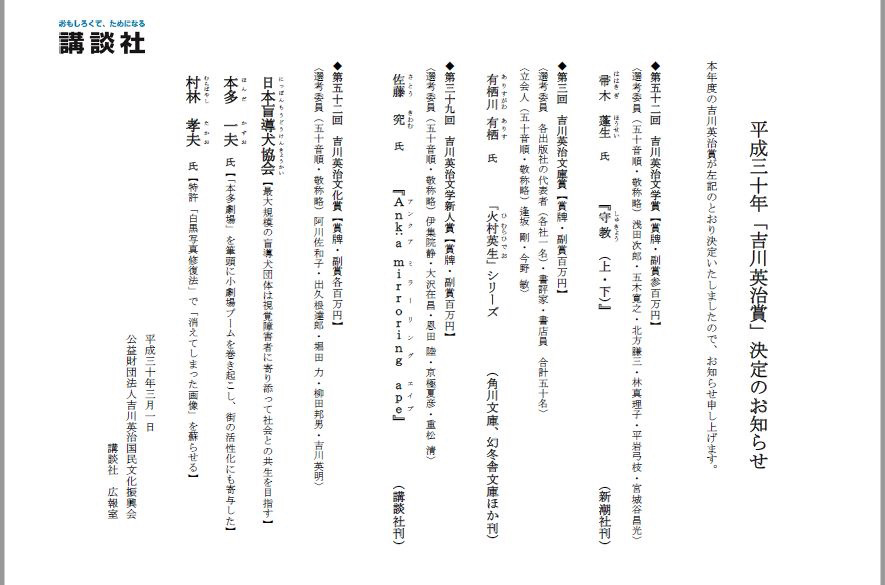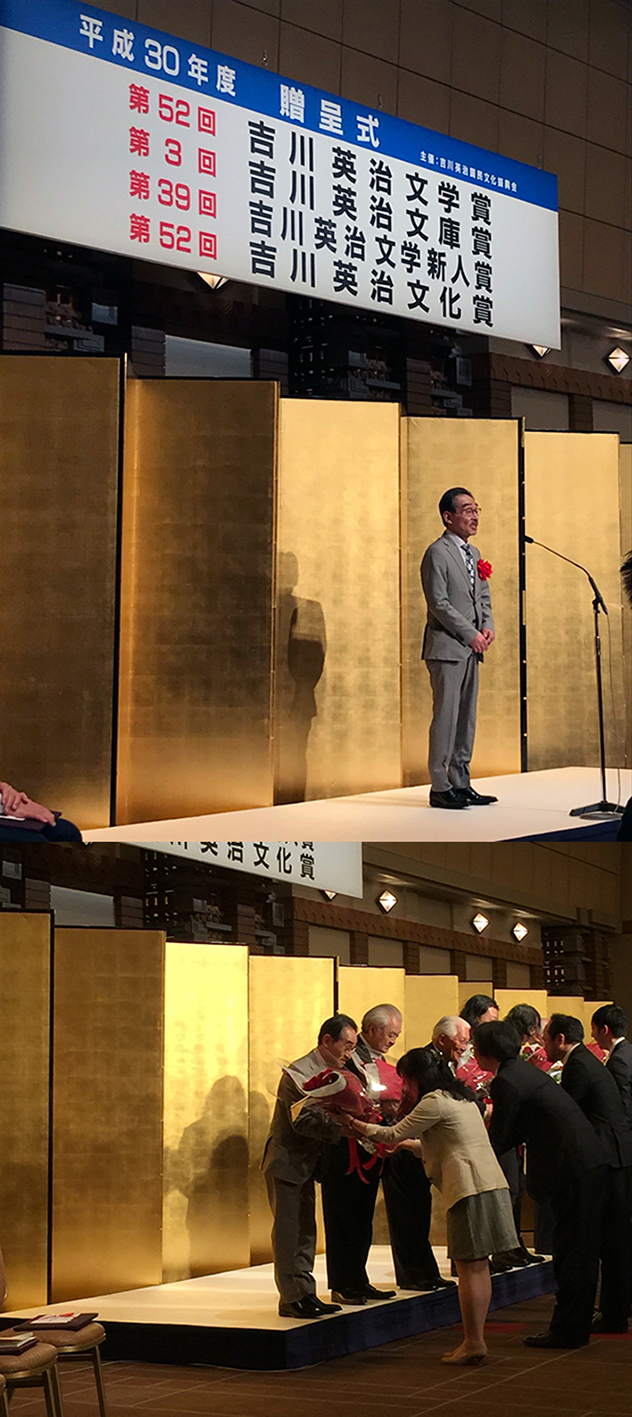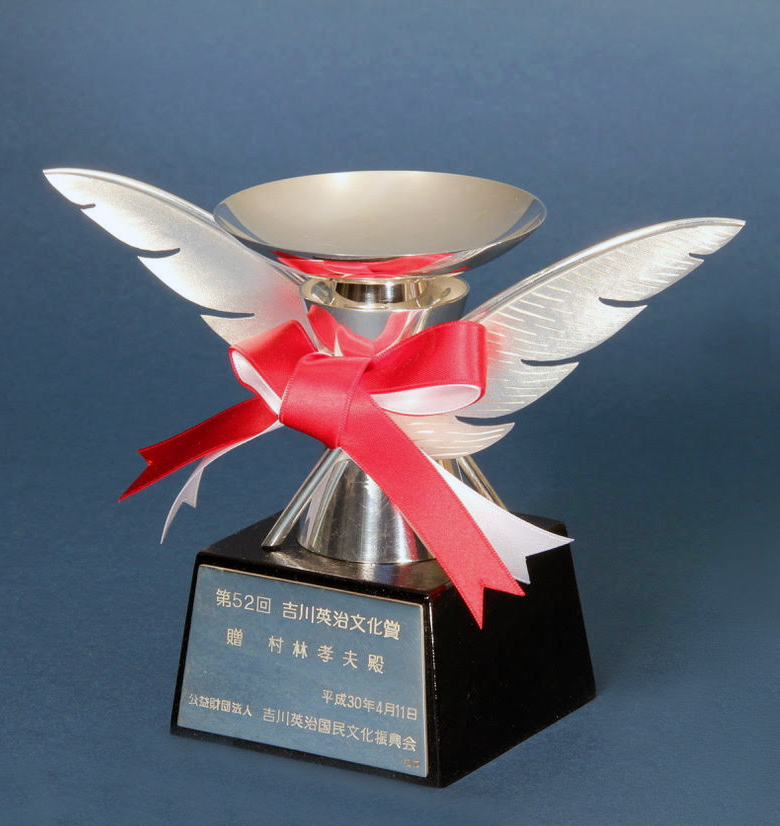村林孝夫が、第52回 吉川英治文化賞を受賞いたしました!

平成三十年度吉川英治文化賞(第五二回)の要項
一、 対象者:
日本文化の向上につくし、讃えられるべき業績をあげながらも、報われ
ることの少ない人、あるいは団体に贈呈します。一、 選考委員(五十音順・敬称略):
阿川佐和子、出久根達郎、堀田 力、柳田邦男、吉川英明一、 賞:
正賞 賞牌一、 候補者の選出に遺漏のないよう、広く文化人、各出版社の編集長、新聞社学芸部長・文化部長・報道部長、ラジオ・テレビ関係者、ならびに中央官庁・政府関係機関・公共企業体・地方公共団体等の関係者の方々に、文章によって推薦を依頼します。
一、 推薦された候補者は、別に定める本会の実施委員によって整理のうえ、
選考委員に提出します。一、 選考委員は合議によって授賞者を決定します。
一、 選考委員ならびに発表は三月上旬に行います。
一、 賞の贈呈式は四月十一日に行います
受賞者経歴
村林孝夫 生年月日 1949年8月8日(68歳)
■ 特許「白黒写真修復法」で「消えてしまった画像」を蘇らせる。
村林孝夫氏は、色褪せたり画像が消えてしまったりした写真を、世界で初めて薬品を使って化学的に修復することに成功。その技は、「百年前の写真をオリジナルそのまま蘇らせる」とも言われる。
村林氏は小学生の頃から広告写真家だった父・忠氏の手伝いをして居た。修復を手がけるきっかけは、1965年、資生堂の福原信三氏らの回顧展が計画され、戦前に福原氏の助手を務めていた忠氏が担当になったことだった。
しかし、オリジナルプリントは散逸、ネガは銀汚染が酷く、企画は頓挫。
ネガの修復に悩む父の姿を見て、村林氏は東京写真大学(現・東京工芸大学)工学部に入学し、化学理論を学びながら、父とともに研究を続けた。
69年にネガから銀汚染を除去することに成功。回顧展が開催され、元版に限りなく近いプリントは好評を博し、福原氏の再評価のきっかけともなった。
89年、忠氏が「一番好きだった作品を元に戻してくれないか。おまえならできる」という遺言とともに逝去。
その言葉を胸に、今度は印画紙の変・褪色の復元と銀汚染除去に挑んだ。
白黒写真は、七十年くらいで画像が不鮮明になってしまう。
村林氏は劣化したプリントを良好な状態に再現すべく写真の原理を突き詰め、十年かけて成功させた。
2003年には「経年変化した白黒写真修復法」として特許も取得。破れやこすれなどの物理的な劣化でなければ修復できる。
1工程は約1時間半、硬膜液、漂白液、清浄液、現像液、停止液などの分量・浸す時間の調整には微妙な感覚が必要。もっとも難しいのは強い光を当てて印画紙の変化を観察しながら行う露光時間の加減で、それによって写真の仕上がりに差が出る。
村林氏は「理論に裏打ちされた作業なので失敗することはない」と語るが、一度真っ白になった画像が現像液の中に再び浮かび上がる瞬間は息をのむほどだ。
現在はデジタル修復(パソコンでの作業)が主流だが、薬品を使った暗室作業である化学修復の最大の利点は、デジタル修復では不可能な、古くなって消えてしまった画像を再現できること。
「家族にとっては一枚の写真が国宝より大事なもの。思い出の写真が蘇り、それを囲む家族の輪が広がることが一番うれしい」と語る。
村林氏はこれまで不可能と言われてきた「鶏卵紙」の写真復元にも成功。幕末から明治中頃に使われてきた鶏卵紙は、紙が薄く、保存状態の悪いものが多いが、修復によって、激動の時代を繙く貴重な資料が見つかる可能性に期待を寄せられる。
また、写真を知り尽くした村林氏は、現像時の手作業によってコントラストを出したグラフィックアートのような銀塩写真を手掛け、高い評価を受けている。
(英文・English)
Takao Murabayashi
Born on August 8, 1949 (aged 68)
Living in Ota, Tokyo
Reviving “lost pictures” by patent Monochrome Photograph Restoration
Mr. Takao Murabayashi succeeded in restoring photographs with their print faded or lost using chemicals for the first time in the world. The technique is said to “restore photographs a hundred years old to their original condition.”
Since he was a schoolboy, Mr. Murabayashi used to help his father Tadashi who was an advertisement photographer. In 1965, the retrospective exhibition of Shinzo Fukuhara and others of Shiseido was planned and Tadashi, who had served as assistant of Mr. Fukuhara before World War II, was placed in charge, which led them to set about photograph restoration. However, original prints were dispersed, negatives were badly damaged by silver pollution, and the plan hit a setback. Watching his father struggling to restore negatives, Mr. Murabayashi entered the department of technology at Tokyo Photograph University (currently Tokyo Polytechnic University) and went on studying with his father as he studied chemical theory. In 1969, they succeeded in depolluting silver. The exhibition was opened and prints extremely close to the originals won popularity, which also appreciated Mr. Fukuhara over again.
In 1989, Tadashi died with his last words, “Bring my favorite work back to the original. You can do it.” Keeping the words in mind, he tried to restore discolored or faded printing paper and to depollute silver in turn. Monochrome photographs lose a clear picture in about 70 years. Mr. Murabayashi discovered the principles of photographs to restore damaged prints to good condition and spent 10 years until he finally succeeded. In 2003, he took out the patent Restoration of Aged Monochrome Photographs. Any damage can be restored except physical deterioration such as wear and tear. The total process takes about one and a half hours. A delicate sense is required to control the quantity and time to dip in hardening, bleaching, cleaning, developing and stopping solutions. It is most difficult to adjust the exposure time, observing the change of printing paper exposed to strong light, which makes a difference in the completion of photographs. Mr. Murabayashi says that “the operations are backed up with theory and would never end in failure,” and indeed the sight would take your breath away the moment you see a picture once whitened turn up again in the developer.
Whereas digital restoration operated on a personal computer is prevalent at present, the greatest advantage of restoration operated in the darkroom with chemicals is to restore old and totally lost pictures, which cannot be digitally restored. He says that “a photograph might be more important for the family than a national treasure. I am very glad to see restored photographs full of memories extend family ties.”
Mr. Murabayashi also succeeded in restoring photographs in “albumen prints”, which had been said to be impossible. Although albumen prints, used from the end of the Edo era to the middle Meiji era, have thin paper and often badly preserved, restoring them is expected to possibly reveal valuable material to read the times of violent change.
In addition, Mr. Murabayashi, who has full knowledge of photographs, has won a high reputation for analog photographs like graphic arts with contrasts manipulated in the process of development.
受賞のことば 村林孝夫

受賞にあたり、複製物であるデジタル再生ではなく、化学変化により修復された黒白写真に光を当てていただけたことを、大変ありがたく思います。 写真を化学的に修復する研究は、二十世紀に世界のフィルムメーカーも行なってきましたが結果を残せませんでした。 写真家の父の遺言を胸に、学生時代の学びを紐解き、約十年の歳月を費やしたのち、2002年にそれを開発しました。 写真業界の常識を覆す革新的な技術であった為か、評価されることなく、写真を修復する必要性は葬り去られそうになりました。 それでも地道に真面目に作業を進めた結果、少しずつ世間の認識も変わり、企業・大学などの評判も高まり、消えかけたオリジナル写真を蘇らせて喜ばれるようになりました。 この度、この賞をいただけたことで、より多くの人に技術を知って貰え、社会や文化の為に貢献できることと存じます。 これは私個人への賞ではなく、写真文化の為にいただけた賞であると考えます。放っておけば消えてしまう運命の写真を、文化遺産として伝えて行く為にもこの技術を知っていただき、世界中の失われていく写真を蘇らせ、救っていきたいと考えます。 光栄ある賞をいただけたことは、励みと共に今後の活動に大きな力を貰えたようで、喜びに溢れています。 ありがとうございました。
(英文・English)
On Winning the Prize Takao Murabayashi
I am very grateful that the prize has cast a light on monochrome photographs restored by chemical change, instead of digital restoration which is actually reproduction.
Chemical restoration of photographs had been studied by film manufacturers all over the world in the twentieth century but any of them could not get results. Keeping in mind the last words of my father who was a photographer, I went over what I had studied at the university and spent about 10 years until I finally established the method in 2002.
My work was not appreciated at first and the need for restoring photographs was almost left behind, possibly because my techniques were so innovative as to overthrow common knowledge in photograph industry.
Yet I persevered in my work steadily and seriously, which changed recognition of the world, and my work has won a high reputation among firms and universities and I have got many words of gratitude for reviving faded original photographs.
I believe that winning this prize can spread my techniques to more people and that I can contribute society and culture.
I think the prize is not only for me alone but for photograph culture as a whole.
I would like to go on reviving and saving photographs being lost all over the world by spreading my techniques to hand down photographs which should be lost without maintenance as a cultural heritage.
This honorable prize encourages me and gives a great power to my future activities, and fills me with great pleasure.
Thank you very much.

選評 知られざる功績 出久根達郎
村林孝夫さんの功績。
世界で初めての技法である。これは、凄い。
古くなって画像が消えかかった。あるいは消えてしまった白黒写真のそれを、薬品を使って復元する。デジタルではできない、消失画像の再現に成功した氏は、写真界のマジシャンである。
村林さんは現在、幕末から明治期の鶏卵紙写真の修復に、取り組んでおられる。私たちは150年前の風景や人物を、今しがたスマホで撮った写真のように、鮮明に見ることができるのである。ワクワクするではないか。
(吉川英治文化賞 選評より抜粋)
お祝いのことば 東北大学大学院文学研究科准教授 大野晃嗣
私が村林孝夫さんに初めてお会いしたのは2013年の夏でした。
当時、私と同僚は、ある一群のガラス乾板を発見しておりました。それは、著名な仏教学者・常盤大常が、東京帝国大学奉職中の1920年(大正九年)から1929年(昭和四年)にかけて、中国大陸で五度の仏教史蹟調査を行なった際に撮影したものであり、その後の苛烈な中国の歴史を思えば、写された内容は、既に失われた仏教史蹟の姿を今に伝え、様々な学問分野で貴重な史料的価値を有すると十分推測されました。
しかし、劣化が進んでおり、あるものはくすんだ色彩をなし、あるものは複数枚が固着し、研究に用いるのは不可能ではないかと苦慮してもおりました。
その修復に名乗りを上げてくださったのが孝夫さんの兄・眞叉夫さん(株式会社リボテック)であり、技術者として孝夫さんも来仙されたのです。
爾来既に四年以上、殆ど経費を提供できない中、現在も修復を進めていただいており、心から感謝しています。
そして、件のガラス乾板が、所謂「デジタル技術」に一切頼ることなく、正確な化学の知識と長年の経験に基づいた完全な手作業によって、深い透明感を帯びた鮮明さを蘇らせる様は、数百枚を実見した今にしてなお、日に驚きを禁じ得ません。
孝夫さんの卓越した技術が常盤のガラス乾板に新しい命を与えつつある今、我々も必ず研究を進めて参ります。
この度の受賞、心よりお祝い申し上げます。
(吉川英治文化賞 お祝いのことばから全文)
